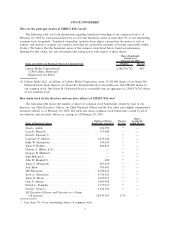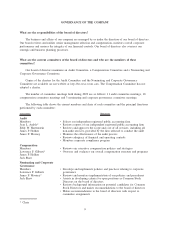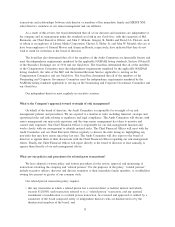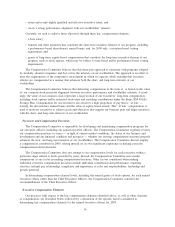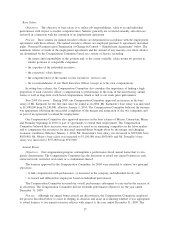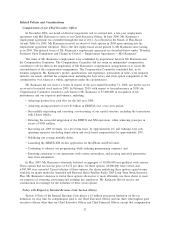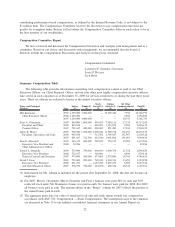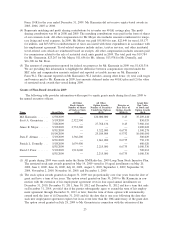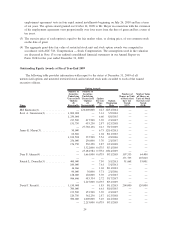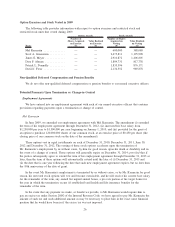XM Radio 2009 Annual Report Download - page 23
Download and view the complete annual report
Please find page 23 of the 2009 XM Radio annual report below. You can navigate through the pages in the report by either clicking on the pages listed below, or by using the keyword search tool below to find specific information within the annual report.• retain and recruit highly qualified and effective executive talent; and
• create a strong performance alignment with our stockholders’ interests.
Currently, we seek to achieve these objectives through three key compensation elements:
• a base salary;
• bonuses and other payments that constitute the short-term incentive element of our program, including
a performance-based discretionary annual bonus; and, for 2009 only, a retention-based vesting
requirement; and
• grants of long-term, equity-based compensation that constitute the long-term incentive element of our
program, such as stock options, which may be subject to time-based and/or performance-based vesting
requirements.
The Compensation Committee believes that this three-part approach is consistent with programs adopted
by similarly situated companies and best serves the interests of our stockholders. The approach is an effort to
meet the requirements of the competitive environment in which we operate, while ensuring that executive
officers are compensated in a manner that advances both the short- and long-term interests of our
stockholders.
The Compensation Committee believes that delivering compensation in the form of, or based on the value
of, our common stock promotes alignment between executive performance and stockholder interests. Accord-
ingly, the value of our common stock represents a large portion of our executives’ long-term compensation,
including stock options and/or restricted stock units and matching contributions under the Sirius XM 401(k)
Savings Plan. Compensation for our executives also involves a high proportion of pay that is “at risk” —
namely, the discretionary annual bonus and the value of equity-based awards. This “at risk” compensation is
used to motivate executives to achieve goals and objectives that support our business plan and align executives
with the short- and long-term interests of our stockholders.
Processes and Compensation Decisions
The Compensation Committee is responsible for developing and maintaining compensation programs for
our executive officers, including our named executive officers. The Compensation Committee regularly reviews
our compensation practices to assess — in light of current market conditions, the status of our business and
development and our financial condition and prospects — whether our existing compensation structure properly
advances the near- and long-term interests of our stockholders. The Compensation Committee did not employ
a compensation consultant in 2009, relying instead on its own significant experience in making executive
compensation-related decisions.
The Compensation Committee does not attempt to set compensation levels for each executive within a
particular range related to levels provided by peers. Instead, the Compensation Committee uses market
comparisons as one factor in making compensation decisions. Other factors considered when making
individual executive compensation decisions include individual contribution and performance, reporting
structure, internal pay relationship, complexity and importance of roles and responsibilities, leadership and
growth potential.
In determining compensation element levels, including the annual grants of stock options, for each named
executive officer (other than the Chief Executive Officer), the Compensation Committee considers the
recommendations of the Chief Executive Officer.
Executive Compensation Elements
Our practices with respect to the key compensation elements identified above, as well as other elements
of compensation, are described below, followed by a discussion of the specific factors considered in
determining key compensation elements for the named executive officers for 2009.
16



